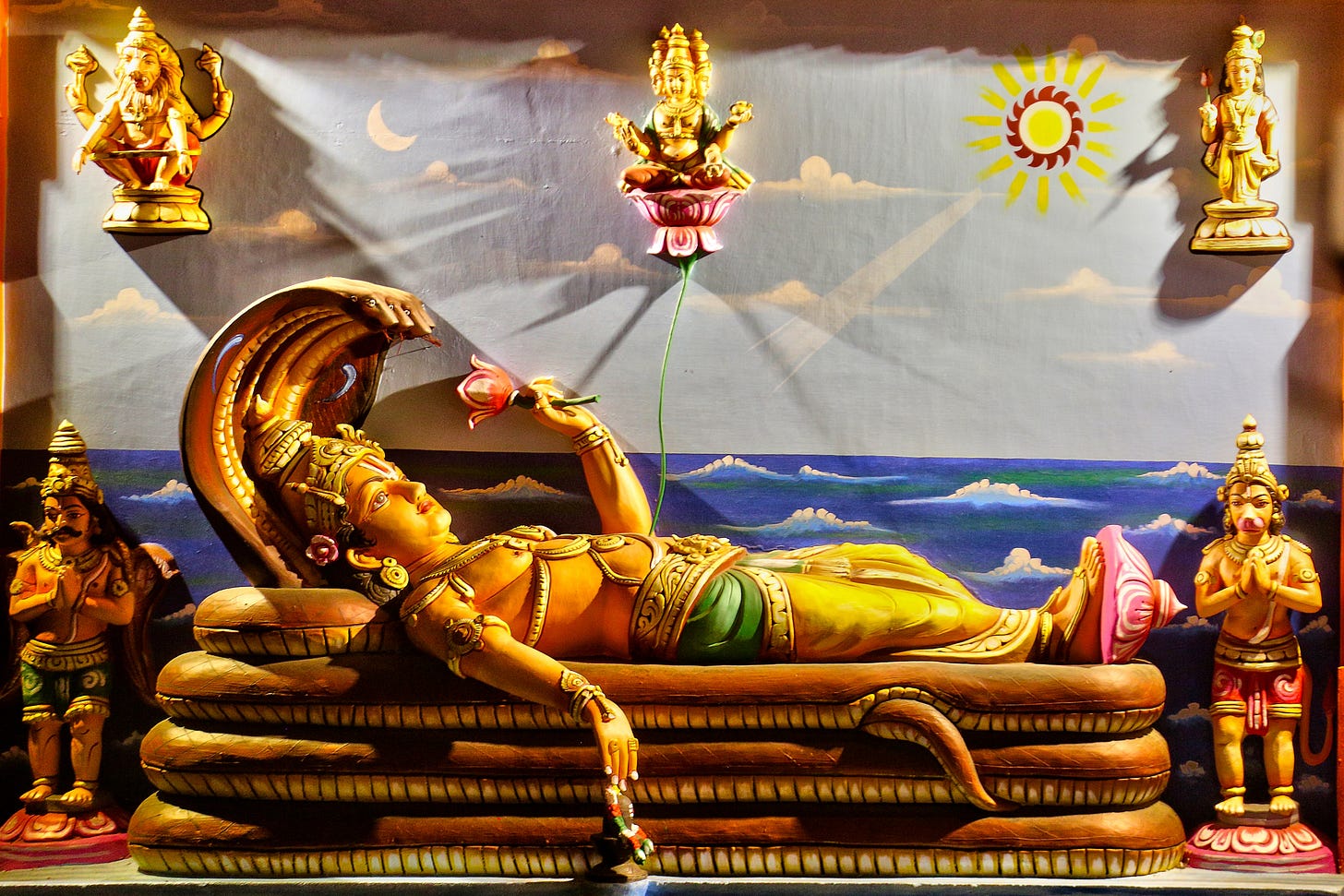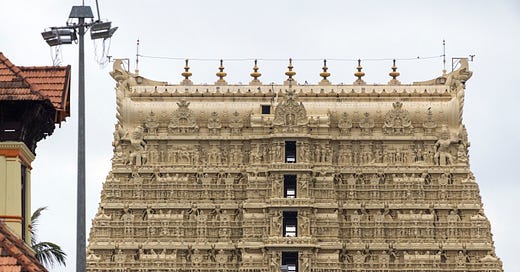The Dark Secrets of India’s Richest Temple
It is said that the dangerous vault B situated inside the famed Padmanabhaswamy Temple is protected by a powerful curse. And whoever tries to open it forcefully would unleash a terrible catastrophe.
The Golden Temple of Priceless Treasures
Imagine an ancient temple with walls made of gold and vaults filled with priceless treasures. Piles and piles of gold coins, ancient golden umbrellas, countless rings, lockets, necklaces of gold and silver, and huge precious stones wrapped in layers of silk.
Enormous hordes of golden bows, arrows, shields and swords, and gold thrones encrusted with thousands of invaluable gems tucked away deep into cavernous vaults. We are talking about trillions of dollars worth of valuables, and this is only the actual value, not the priceless antique cost, which will be, of course, priceless even if we attempt to estimate it.
Welcome to the Padmanabhaswamy Temple lying within the state of Kerala, India. The Padmanabhaswamy Temple is among the wealthiest ones in the world, with some texts dating from before 500 BC referring to it as “The Golden Temple” and claiming it was made almost entirely of solid gold in the ancient times.
And more than the gold, the ancient mysterious secrets of the temple make fascinating reading, with much of the complex still unexplored or kept secret from the outside world for hundreds of years.

The Padmanabhaswamy Temple
The name Padmanabhaswamy is derived from the word Padmanabha, meaning “One emerging from the lotus.”
Dating back from at least the 6th century onwards, the temple had been under the guardianship of the Kings of the Travancore Royal Family, who steadily renovated it throughout up to the 20th century, after which the control of the temple passed to government hands.
The temple is one of the 108 temples of Vaishnavism or the worship of Vishnu. One of the main deities of Hinduism. the temple prominently displays an enormous statue of Vishnu depicted in an unusual reclining position upon the five-hooded serpent, with the whole deity measuring 20 feet square and carved from a single monolithic slab of stone.
The temple has six underground vaults, which archaeologists inspected in 2001, labeled from A to F. Vaults A and C store extensive gold treasures. D and E have gold and silver jewelry, and F has utensils and other temple ritual stuff. This was the first time the temple treasures were officially explored after long being mostly closed off entirely from the outside world by the secretive royal family of Travancore.
And what the archaeologists found was an insanely vast trove of treasure far beyond perhaps anyone’s expectations. The multiple vaults overflowed with more than $20 billion in treasures. These include idols hewn out of solid gold, gold coins from around the world, and necklaces and costumes studded with rubies, emeralds, and diamonds.
As a government committee member who was sent to oversee the project, said later.
“I looked into the black pantry, and I saw an amazing sight: as stars shimmered in the sky on a moonless night. Diamonds and other precious stones flashed, reflecting the faint light coming from the open door. Most of the treasures were stacked in wooden chests, but eventually, the tree turned into rubbish. Precious stones and gold simply lay in piles on the dusty floor. They were not really arranged systematically. There were baskets, some earthen pots, some copper pots, and in all these things, these things were kept. It was a magnificent experience. There are no words to describe it. I have never seen anything like this.”
But the search abruptly stopped when the team came across the seemingly impenetrable “Vault B.”

The Mysterious Vault B
The Travancore royal family strongly objected this time and opposed the opening of this particular vault, citing that it would be disrespectful to the temple’s central deity and lead to widespread catastrophe for not only the Indian people but possibly the entire world. Interestingly, only the doors of Vault B are adorned with stone-carved images of serpents guarding its mysterious contents.
And according to legends, the door is impossible to open by any earthly means. It is said to be sealed by a Vedic spell that could only be deciphered by either the one who had cast it or an equally powerful priest. And anyone who tries to open the door forcefully will unleash an unimaginable catastrophe that would plunge the world into a cataclysm of gigantic proportions.
Temple scribes also mention that some temple priests tried unlocking the door around three hundred years ago so they could make use of the treasure to save the country from the ongoing famine at the time. But as they got closer, they could hear gushing waves behind the door.
And as they tried prying open the door, they were attacked by a hoard of snakes that appeared out of nowhere. The priests beat a hasty retreat, and the vault was never attempted to be opened again since then.
And in modern times, many of the original committee members who were tasked with trying to open the vault have met with freak accidents, misfortune, and death, further strengthening the idea that the vault is cursed. This further reinforced the belief in the words of the royal family on the dangerous curse that protects the secret of the vault.
The Travancore royal family filed an injunction in the court against opening Vault B—an injunction that still stands today. As per the law, no one can open that door for now. As Uthradom Thirunal Marthanda Varma, the 90-year-old head of the erstwhile Travancore royal family, later replies to a question about vault B.
“I know what is in vault B. But what is the necessity for everyone to know about it? It is just idle curiosity and bad behavior,”
And he will not speak any more on that. He has closed the chapter, his mind, and his eyes. Some secrets are just not meant to be revealed.
The vault remains unopened to this day.

Travel details
How to Reach Padmanabhaswamy Temple: Trivandrum International Airport is located just 4 kilometers away from the temple. Cabs and autorickshaws are available up to the temple. Trivandrum is also well connected to all major cities by train, and Trivandrum railway station is just 1.4 km away from the temple.
Dress code and decorum: Men should only wear dhotis, and women should wear traditional Indian wear. No photography is allowed within the temple. You are not allowed to carry any electronic gadgets within the temple.
Darshan timings: Morning 3,00 – 9.00 am and evenings 5.00 – 7.30 pm.
Best time to visit – Any time of the year
Entrance fees – Free.
The Lakshadeepam Festival
On the occasion of the Lakshadeepam festival, the temple is lit up with 100,000 oil lamps all around its structure and within the temple premises. This festival takes place once every six years and involves ceremonial chanting of the three Vedas- Rig Veda, Sama Veda, and Yagura Veda, each lasting eight days.
As part of the festivities, the idols of Sree Padmanabhaswamy, Narasimha, and Thiruvambadi Sree Krishna are also displayed in full grandeur.
Sources
· The Padmanabhaswamy Temple Treasure - The Mystery Behind The Richest Temple in India
· The Trillion Dollar Treasure of Padmanabhaswamy Temple
· The Mystery Of Padmanabhaswamy Temple
· Padmanabha Swamy Temple and the Secret Royal Treasure in Vaults
· All about Padmanabhaswamy Temple, its treasures, and the royal family that will control it
· Padmanabhaswamy: The mysterious door no one has opened until now






sree rama temples tour in south india : https://www.keralaholidays.com/tourpackages/Kerala-Temple-Tour
Complete guide to visit Padmanabha Swamy temple https://www.keralatourpackages.com/blog/padmanabhaswamy-temple-trivandrum/